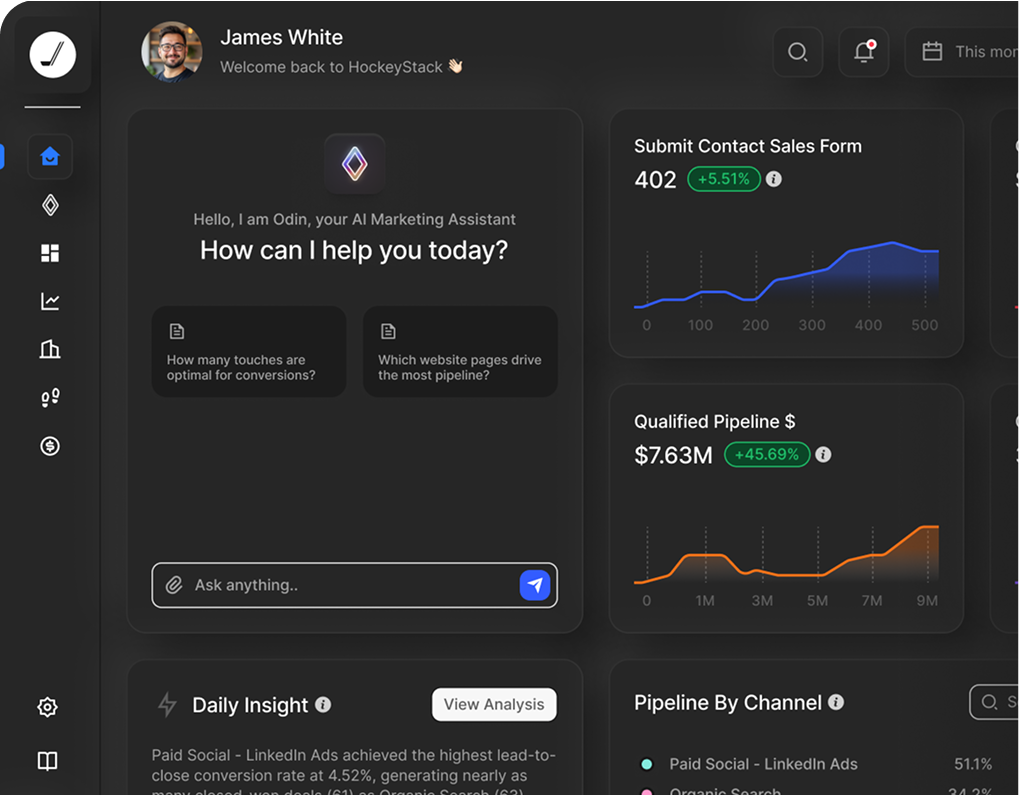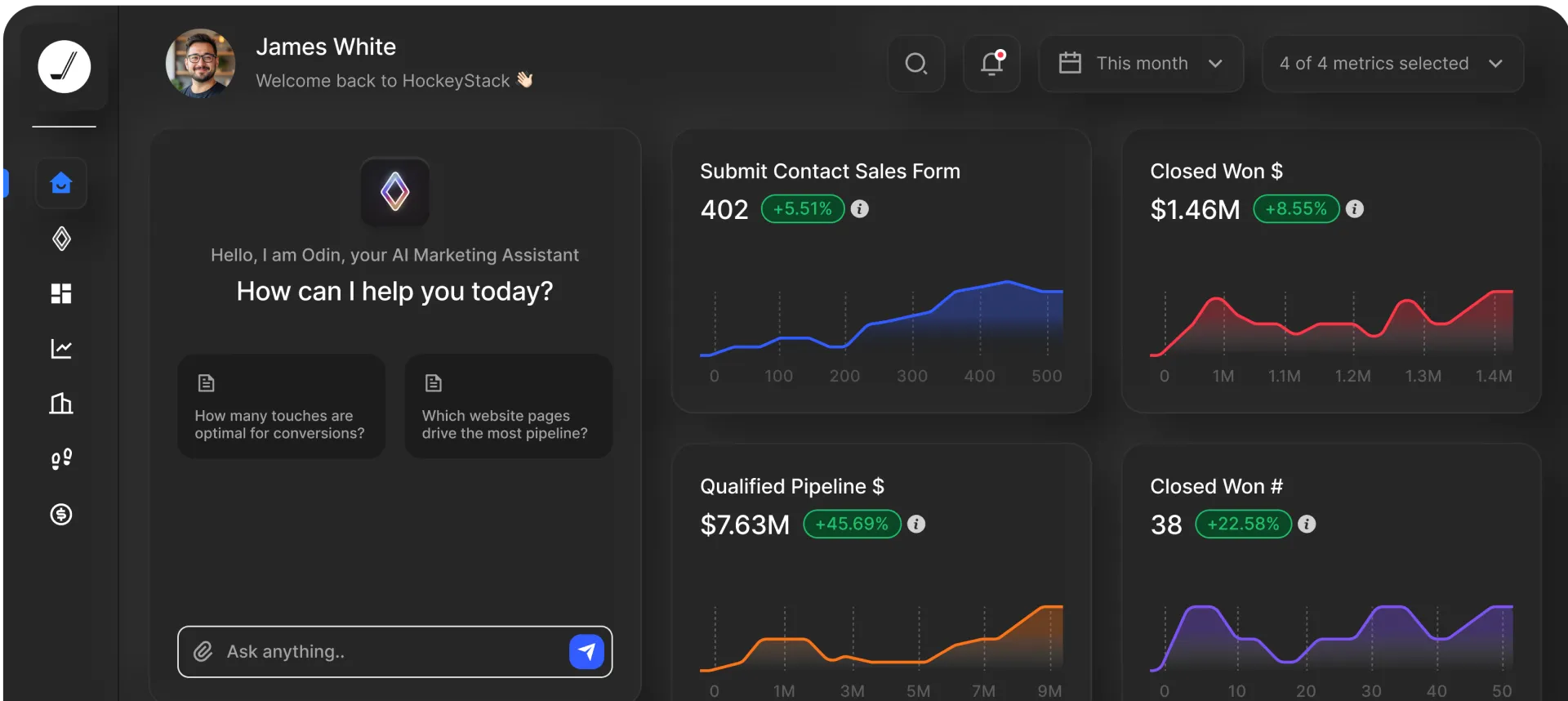Predictive Analytics in GTM: Complete Guide for Revenue Teams

Predictive Analytics in GTM: Complete Guide for Revenue Teams

The B2B market is shifting faster than plans can be executed. Deals are also stalling without warning. This is already putting a lot of pressure on GTM teams.
Yet, leadership still expects forecasts to be ‘airtight.’ And not to say it’s impossible, but traditional GTM strategies weren’t built for this speed.
Lack of data is not the issue here. If anything, teams are already drowning in dashboards, reports, and metrics.
The tricky part is filtering that data. Knowing what’s worth acting on, what intent signals matter, what prospects are active now, and how to retain them the longest.
Predictive analytics looks to be the solution to this, as it helps GTM teams see patterns before they unfold.
In this guide, we’ll walk through what that looks like in practice, why it matters, and how revenue teams can apply AI-powered insights to gain a competitive edge.
What is AI Predictive Analytics?
First, we have to understand what ‘predictive analytics’ means…
Predictive analytics is the practice of using historical and real-time data, combined with advanced statistical models and machine learning, to forecast future outcomes.
It describes;
- what has already happened (descriptive analytics),
- why it happened (diagnostic analytics), and
- what is likely to happen next (this is where you get ‘predictive’).
When you add artificial intelligence to this, predictive analytics becomes smarter, and more adaptive.
Now you have AI models that can process massive volumes of structured and unstructured data. Things like CRM records, product usage logs, marketing engagement, call transcripts, or even external intent data. And use that to identify patterns that would be somewhat invisible to human analysis.
AI Predictive Analytics in a GTM Context
For go-to-market teams (marketing, sales, customer success, and revenue operations) AI predictive analytics helps turn customer data into clear, actionable foresight that guides every revenue motion.
- For marketing: It predicts which segments are most likely to engage, which campaigns will generate pipeline, and which leads are closest to sales readiness.
- For sales: It helps prioritize accounts by showing which deals are most likely to close, which opportunities need more nurturing, and which accounts are likely to stall.
- For customer success: It forecasts churn risk and identifies upsell or cross-sell opportunities by analyzing behavioral signals, usage patterns, and sentiment trends.
- For RevOps and leadership: Predictive models improve pipeline forecasting accuracy, helping leaders allocate budgets, headcount, and strategy with confidence.
Related → 5 GTM AI Implementation Best Practices for Revenue Teams
How AI Predictive Analytics is Different from Traditional GTM Methods
Traditional GTM segmentation or forecasting models often rely on rules-based logic—e.g., “if a lead attends a webinar, add 10 points to their score.”
While this approach is ‘simple’, it quickly falls apart when you start scaling.
For example, a prospect who passively registers for five webinars but never opens a single follow-up email might be ranked higher than an account that only attended one event but also engaged deeply with product documentation, pricing pages, and competitor comparison content.
In the rules-based model, both leads look “hot,” but only one is truly showing intent to buy.
Meanwhile, AI predictive analytics focuses more on interpreting patterns across time and channels. It learns which behaviors actually correlate with conversions in your pipeline.
That means it can recognize the difference between surface-level engagement and genuine buying intent, automatically adjusting lead and account scores as new signals come in.
Going back to the webinar example, AI might flag the other account (that didn’t attend multiple webinars) as a ‘high-value’ target because their product usage logs show a sudden spike in trial activity combined with visits to the pricing page.
💡Stack Insight → AI predictive analytics in GTM is about seeing the future with data. It unifies signals across the funnel, identifies the behaviors that matter most, and translates them into predictions and actions that help revenue teams make the data-driven decisions.
Related → AI-Driven vs. Traditional GTM Strategy: A Head-to-Head Breakdown
The 3 Core Components of AI Predictive Analytics
Predictive analytics is a disciplined system built on three core components working in sync: the data you feed it, the algorithms that find the patterns, and the predictions it produces.
Each part is critical, and together they create a cycle that continuously improves over time.
Data
Predictive analytics begins with data. Without high-quality data, even the most advanced algorithms produce unreliable outputs.
In a GTM context, this includes a wide range of sources that captures how customers interact with your business:
- Internal/first-party data: CRM records (pipeline history, win/loss outcomes), marketing engagement (clicks, opens, downloads), and product usage analytics (logins, feature adoption).
- Customer feedback and support data: NPS scores, tickets raised, sentiment in conversations.
- External/third-party intent data: Content consumption patterns across the web, social media, industry research spikes, competitor page visits.
However, ‘volume’ is not the aim here. What we want is clean and normalized data. If one platform lists a company as “Stack Inc.” and another as “Stark Incorporated,” AI models may treat them as different entities, corrupting insights.
Machine Learning Algorithms
Once data is collected and cleaned, machine learning algorithms analyze it to detect patterns. These algorithms work by training on historical data to identify correlations and then applying that knowledge to predict future outcomes.
The strength of machine learning is that it improves with exposure. Every won deal, lost opportunity, or churned account becomes feedback that fine-tunes the model.
Over time, the algorithm develops a sharper, more context-aware understanding of what signals predict outcomes in your unique GTM motion.
Predictions
The final component is the prediction itself. The actionable insight that revenue teams can use to make informed decisions.
Predictions might take the form of:
- Lead scores: Assigning a probability that a lead will convert into an opportunity.
- Churn probabilities: Showing which customers are at risk of canceling.
- Upsell potential: Highlighting which accounts are ready for expansion.
- Revenue forecasts: Predicting pipeline value
Predictions give revenue teams the confidence to allocate resources where they’ll have the most impact.
For example, a CRO reviewing quarterly forecasts can see the total pipeline value and also a probability-weighted forecast—showing that while there’s $10M in open pipeline, predictive models estimate only $6.5M is likely to close. This improves accuracy and helps the board plan realistically.
💡Stack Insight
- Data provides the raw truth about customer interactions and overall behavior.
- Algorithms process that data and uncover hidden patterns.
- Predictions transform those patterns into actionable foresight for GTM teams.
Related → Types of Marketing Analytics: Effect on Marketing Strategies
Predictive Analytics Techniques
Predictive analytics relies on a range of statistical and machine learning techniques. With each having its own strengths and use cases.
However, when you mix or layer them together they can help revenue teams forecast outcomes, segment customers, optimize sales strategies, and improve their GTM workflow.
The four most commonly applied techniques are regression models, classification models, clustering models, and time series analysis.
1. Regression Models
Regression models are the foundation of predictive analytics. They work by quantifying the relationship between a dependent variable (the outcome you want to predict) and one or more independent variables (the factors influencing that outcome).
In simple terms, they assign weights to each variable to estimate the likelihood of an outcome. This gives teams a quantifiable and interpretable model for understanding which variables most influence pipeline, revenue, and churn.
For example, you might model how lead engagement scores, company size, and number of product demos collectively influence the probability of deal closure.
And there are two types that apply well to GTM:
- Linear regression: Predicts continuous outcomes such as deal value, expected revenue, or average contract size.
- Logistic regression: Predicts binary outcomes such as will churn vs. won’t churn or will convert vs. won’t convert.
💡Example: A SaaS company could use regression to forecast monthly recurring revenue (MRR) by factoring in historical sales velocity, win rates, and average deal size.
Or logistic regression could determine which onboarding behaviors (like completing a setup tutorial) are most predictive of customer retention.
2. Classification Models
Classification models predict which category an observation belongs to—i.e.,“which group.”
They’re particularly powerful in sales and marketing where the task often involves sorting leads or accounts into categories.
Common methods include:
- Decision trees: Split data into yes/no questions until a classification is reached.
- Random forests: Multiple decision trees combined for stronger accuracy.
- Support Vector Machines (SVM): Draw decision boundaries between categories.
- Neural networks: Handle highly complex classification with many inputs.
Here are a few ways to apply it in GTM:
- Predictive lead scoring: Classifying leads as “hot,” “warm,” or “cold.”
- Churn prediction: Classifying customers as “at-risk” vs. “healthy.”
- Opportunity qualification: Identifying which deals are “likely to close” vs. “likely to stall.”
💡Example: Let’s say you’ve logged thousands of deals in your CRM. A classification model could learn from patterns (deal stage duration, decision-maker involvement, competitor mentions) and predict whether a new opportunity should be prioritized as high-likelihood-to-close.
3. Clustering Models
Clustering is about finding natural groupings in data without predefined categories. It’s an unsupervised learning technique. This means the AI isn’t told what groups exist but instead discovers them based on similarities in the data.
Common methods include:
- K-means clustering: Groups data into k clusters based on similarity.
- Hierarchical clustering: Builds nested clusters in a tree-like structure.
- DBSCAN: Finds clusters of varying shapes and densities (useful for messy data).
Here are few ways to apply it in GTM:
- Market segmentation: Identifying groups of accounts with similar buying behaviors.
- Personalization: Creating tailored nurture journeys for clusters like “price-sensitive buyers” or “innovation-driven adopters.”
- Product usage insights: Grouping customers based on feature adoption to design upsell plays.
💡Example: A B2B SaaS tool might discover three distinct clusters:
- Early-stage startups with low budgets but high growth potential,
- Mid-market companies prioritizing integrations, and
- Enterprise buyers focused on compliance.
Marketing can design different messaging strategies for each, while sales adjusts its pitch by cluster.
4. Time Series Analysis
Time series analysis is used when data is collected over time and the goal is to forecast future trends. It accounts for temporal patterns, including seasonality (recurring cycles), market trends (long-term direction), and noise (random fluctuations).
Common methods include:
- ARIMA (Auto-Regressive Integrated Moving Average): Classic statistical model for forecasting.
- Exponential smoothing: Weighs recent data more heavily to predict near-term trends.
- Recurrent Neural Networks (RNNs): Advanced deep learning for sequential data like time-based customer behavior.
Here are few ways to apply it in GTM:
- Revenue forecasting: Predicting quarterly sales based on historical booking patterns.
- Pipeline health monitoring: Spotting when opportunity creation slows and predicting the downstream impact.
- Customer engagement trends: Forecasting usage dips to identify accounts likely to disengage.
💡Example: A RevOps leader can use time series to forecast next quarter’s pipeline contribution from marketing campaigns. By analyzing multi-year seasonality (e.g., Q4 spikes), the model predicts when to ramp spend or when to hold back.
Benefits of AI Predictive Analytics
Brings Accuracy and Confidence to Revenue Forecasting
Forecasting has traditionally relied on rep intuition and spreadsheets. That makes it vulnerable to optimism, bias, or incomplete data.
Predictive analytics replaces this ‘guesswork’ with probability-weighted sales forecasts based on historical close rates, deal velocity, rep performance, and seasonality.
Instead of treating every deal in the pipeline equally, AI adjusts forecasts to reflect real closing likelihoods. In this case, a $100K deal sitting idle for 90 days won’t carry the same weight as a $50K deal with strong engagement and rapid momentum.
Enables Smarter Marketing Spend
Marketers face constant pressure to prove ROI. Campaigns are expensive, and leadership wants to know where every dollar is going.
Predictive analytics helps marketers by showing which campaigns, channels, and customer segments are most likely to generate revenue.
For example, AI may show that webinar leads in healthcare convert at twice the rate of leads from paid social campaigns in e-commerce. This allows teams to double down on high-performing channels and cut wasted spend elsewhere.
Reduces Churn Through Early Warning Signals
Customer churn is a big threat to every recurring revenue business (e.g., SaaS). By the time a customer cancels, it’s often too late to win them back.
On the flip side, you can get ahead of this when you see the signals early on.
For example, AI models might detect declining customer satisfaction due to a sudden drop in product logins combined with a spike in support tickets. It then predicts based on this pattern, customers are 3x more likely to churn within 90 days.
With this knowledge, customer success managers can step in with personalized outreach to improve the customer experience. They can offer training sessions, additional resources, or special incentives—all to keep the relationship alive.
Creates Opportunities for Upsell and Cross-Sell
Revenue growth doesn’t ‘always’ come from acquiring new customers. It can also come from deepening relationships with existing ones. With predictive analytics, you can discover expansion opportunities by spotting patterns in customer behavior that indicate readiness for more.
For example, a mid-market SaaS customer consistently hitting user limits might be flagged as a strong candidate for an enterprise upgrade. Another account heavily adopting a core feature might be ready for a related add-on product.
By surfacing these opportunities automatically, revenue teams can drive account growth without additional acquisition costs.
Prioritizes the Right Leads for Sales
Sales teams are often flooded with leads, many of which look promising on ‘paper’ but have no real intent to buy. This creates inefficiency as reps chase dead ends while losing out high-potential accounts.
Predictive analytics solves this by ranking leads based on conversion likelihood, using both behavioral data (content engagement, demo requests, usage trials) and firmographic data (industry, company size, role).
This helps increase win rates and also shortens the sales cycle. With this, reps can walk into conversations knowing which leads are statistically most likely to move forward and which objections they’re likely to encounter.
✨Feature Highlight✨
The entire buyer journey from the first impression to closed-won.

Track all touch-points across the buyer journey, match anonymous activity to revenue, and see beyond first/last-touch.
How to Implement a Predictive GTM Strategy
- Define Your GTM Goals and Success Metrics
- Audit and Integrate Your Data Sources
- Select the Right Predictive Models
- Build, Train, and Validate Your Models
- Operationalize the Insights
- Monitor, Measure, and Refine Continuously
Step 1: Define Your GTM Goals and Success Metrics
Every predictive system needs a clear purpose. That means before you go into the ‘data’ and ‘algorithms’ you need to define what success looks like for your business.
- Are you trying to improve lead-to-opportunity conversion rates?
- Do you need more accurate revenue forecasting?
- Do you want to prevent churn or identify upsell opportunities?
Your goals will shape which data to collect, what models to train, and how predictions will be used. For example, if churn prevention is your focus, usage and support interaction data will matter far more than webinar registrations.
💡Stack Insight → Choose 2-3 primary KPIs (e.g., pipeline coverage, win rate, churn rate) that are tightly tied to GTM outcomes.
Next, define both leading indicators (engagement signals, demo requests) and lagging indicators (closed-won deals, churn events).
Finally, establish a baseline so you can compare predictive impact later.
Step 2: Audit and Integrate Your Data Sources
Predictive analytics thrives on high-quality, diverse data. This step involves mapping all existing data sources (first- and third-party).
The goal is to break down silos and create a unified dataset that can strengthen the model. This often requires data integration tools like (ETF pipelines) or attribution platforms like HockeyStack to clean, normalize, and consolidate information.
💡Stack Insight → While data volume is an important factor, also prioritize variety and relevance. For example, sales activity logs paired with product usage data often reveal stronger predictive patterns than marketing activity alone.
Related → Best AI-Powered GTM Solutions in 2025 and Beyond
Step 3: Select the Right Predictive Models
Once your data foundation is set, the next step is choosing the right modeling approach. Different predictive techniques serve different GTM needs:
- Regression models for understanding how variables impact conversion likelihood or deal size.
- Classification models for lead scoring, opportunity qualification, or churn prediction.
- Clustering models for uncovering hidden customer segments.
- Time series analysis for forecasting pipeline growth or customer behavior trends.
Most companies will use a combination of these techniques. The key is aligning model choice with your business goals from Step 1.
💡Stack Insight → Start simple. Use one or two models to address your highest-impact problem (e.g., lead scoring) before expanding to more advanced use cases.
Recommended → 9 Best AI Agents for GTM Teams on the Market Right Now
Step 4: Build, Train, and Validate Your Models
Next is to feed historical data into your models, train them to identify patterns, and validate them against test datasets.
The validation step is crucial because, without it, you risk overfitting (where the model performs well on past data but fails in real-world scenarios).
You’ll also need to regularly retrain models as market conditions and customer behaviors evolve.
💡Stack Insight → Track accuracy metrics like precision, recall, and lift to evaluate how well your model predicts outcomes compared to random chance or traditional methods.
Step 5: Operationalize the Insights
The next step is operationalizing insights so they directly impact GTM execution. That could mean:
- Integrating lead scores into your CRM so sales reps know which accounts to prioritize.
- Triggering automated marketing campaigns when churn-risk signals appear (e.g., a 70% churn risk triggers a CSM outreach + retention offer).
- Updating forecast dashboards for leadership based on real-time probability scores.
The goal is to move predictions from “insight” to “action” seamlessly, embedding them into daily workflows.
💡Stack Insight → Tie every prediction to a clear next step. If the model flags a high-converting lead, define exactly what sales should do (e.g., send a tailored case study or book a demo within 24 hours).
Step 6: Monitor, Measure, and Refine Continuously
The final step is creating a feedback loop to ensure your go-to-market strategy remains effective. For this, you need to monitor outcomes regularly, compare predictions to actual results, and adjust models as needed.
Over time, you’ll identify where the models are strongest (e.g., churn prediction) and where they need refinement (e.g., forecasting accuracy). This approach ensures the system keeps getting sharper, delivering compounding benefits.
💡Stack Insight → Build a predictive performance dashboard that shows both business KPIs (pipeline velocity, win rates) and model accuracy metrics.
This way, you’re tracking both outcomes and the reliability of the predictions to improve your decision-making processes.
Related → 10 Best Marketing Intelligence Tools for GTM Teams
Common Challenges with AI Predictive Analytics in GTM (And How to Overcome Them)
Poor Data Quality and Fragmentation
The reason most GTM teams have problems adopting predictive analytics is due to their bad and fragmented data.
Predictive models rely on accurate, complete, and consistent data to produce reliable insights. But in most organizations, data lives in disjointed systems;
- Marketing tracks campaigns in one platform,
- Sales logs interactions in another,
- Product usage data sits in analytics tools, and
- Customer success stores renewal notes in yet another system.
On top of this fragmentation, the data itself is often riddled with issues—like duplicates, missing fields, outdated contacts, inconsistent naming conventions, or incomplete activity logs.
For example, if your CRM still has “test@test.com” leads from two years ago, or product usage data that isn’t connected to account IDs, those inaccuracies will flow directly into your predictive model.
For predictive analytics, this problem compounds. Unlike descriptive analytics, where flawed data may just skew a report, predictive models amplify small inconsistencies into big misjudgments.
A dirty dataset can lead to false signals. For instance, flagging the wrong customers as churn risks, misclassifying high-value leads as low priority, or generating wildly inaccurate forecasts.
💡Solution: Build a Unified, Clean Data Foundation
The first step toward overcoming data challenges is creating a unified, reliable data layer before predictive models are deployed.
This requires both a technical and an operational approach:
- Centralize your data sources: Connect CRM, marketing automation, product usage, support systems, and third-party intent data into a single source of truth. A customer data platform (CDP) or a GTM analytics platform like HockeyStack can do this effectively.
- Standardize formats and fields: Make sure dates, job titles, revenue fields, and company names follow a consistent format. This avoids duplicate or mismatched records.
- Automate data hygiene: Set up rules that flag duplicates, auto-enrich missing details, and archive outdated records.
Lack of Trust in the System
Even when predictive analytics is ‘technically’ sound, GTM strategies often fail because teams still don’t trust the outputs.
Sales reps may see a lead scored as “high intent” but feel it doesn’t match their experience. Marketing might question why certain accounts are prioritized while others aren’t. Customer success might doubt churn risk flags if they’ve recently had positive interactions with an account.
This skepticism usually comes from two factors:
- Black-box algorithms: Predictive models can seem opaque. If a rep doesn’t know why a lead is ranked higher, they’re less likely to act on it.
- Past experiences with bad data: If the system has been wrong before (due to messy data or poor calibration), trust is quickly lost, even if the model improves later.
This leads to predictive analytics being underused or ignored. And since the predictive layer exists, but the human layer doesn’t embrace it, the strategy never reaches its full potential.
💡Solution: Ensure Transparency and Prove Value Early
Teams need to understand how and why the model arrived at its conclusion. They also need to see early, tangible wins that prove predictive insights actually improve their outcomes.
Some practical steps you can take include:
- Explaining the reason behind predictions: Don’t simply say “Lead A has a 70% chance of converting,” show the contributing factors (e.g., engaged with 3 product demos, matches ICP (ideal customer profile), opened last 4 nurture emails).
- Embedding predictions into workflows: Don’t make teams switch tools. If sales lives in Salesforce or HubSpot, show predictions there. If CS lives in Gainsight, deliver churn alerts directly inside the platform.
- Communicating quick wins: Share success stories internally. For example: “This account was flagged at-risk, CS intervened, and we saved $200K in ARR.” These narratives build confidence and encourage wider adoption.
Risk of Overfitting
Overfitting is when an AI predictive model learns the training data too well. In this case, they capture noise, anomalies, or irrelevant details.
While the model looks highly accurate in testing, it performs poorly when applied to new, real-world data.
For example, if a model was trained heavily on last year’s top accounts, it might incorrectly assume that all new accounts must match those exact characteristics to be high-value. That blinds revenue teams to fresh opportunities and emerging patterns.
💡Solution: Regularly Validate Models
The best way to combat overfitting and inaccuracy is through rigorous validation and continuous refinement.
Some ways include:
- Using cross-validation techniques: Split historical data into training and test sets to ensure models perform well on unseen data.
- Monitoring for drift: Customer behavior changes over time (e.g., a pandemic shifts buying cycles). Continuously monitor whether model performance is degrading due to “data drift.”
- Limiting over-complexity: Avoid stuffing models with every available variable. Focus on features with proven predictive value (e.g., usage depth, industry, deal size).
- Retraining regularly: Set a cadence (monthly, quarterly) to retrain models with the latest data.
- Layering human oversight: Have RevOps or data analysts review model outputs periodically. Human judgment can catch blind spots that algorithms miss.
Data Privacy and Compliance Concerns
Regulations such as GDPR (Europe), CCPA (California), and HIPAA (healthcare in the U.S.) impose strict rules on how customer data can be collected, stored, and processed.
For GTM teams, this creates an endless cycle. They need to enrich the dataset to get better predictions. However, the more data they use, the higher the compliance risk.
It gets worse when revenue teams pull together multiple data sources without fully considering privacy implications.
For example, using sensitive customer details (e.g., location, personal identifiers, support conversations) without proper consent could violate laws. A recent case was the €20 million fine issued to Clearview AI’s by the Italian Data Protection Authority (Garante per la protezione dei dati personali) for breach of customer privacy [*].
AI models may also surface insights that expose protected categories (like inferring gender or income levels) that companies should not act on.
Even if no law is broken, there’s a trust issue. If customers feel their data is being exploited without transparency, the brand risks reputational damage.
💡Solution: Incorporate Compliance and Ethics into the Predictive System
Practical steps include:
- Data minimization: Only collect and process the data truly necessary for predictions. For example, instead of analyzing every customer support transcript, focus on anonymized sentiment scores.
- Anonymize and aggregate sensitive data: Remove personally identifiable information (PII) before training models. Work with aggregated trends rather than exposing individual profiles unnecessarily.
- Consent-first approach: Make sure data used in predictive analytics comes from customers who have opted in. Be transparent in your privacy policy about how predictive analytics is used.
- Cross-functional oversight: Involve legal, compliance, and security teams early in building predictive systems. This ensures predictive models align with regulatory requirements from day one.
Predictive GTM with HockeyStack: The Edge Your Revenue Team Needs
And teams at Delve can already attest to this:
“We’re not wasting time anymore. Everyone sees what’s working—attribution, spend, experiments, all of it—and we can act on it immediately.”
HockeyStack unifies all your GTM data into one connected platform. From there, it applies machine learning to map customer journeys, assign predictive deal scores, and highlight the campaigns that move revenue forward.
What you get is a predictive GTM system that adapts to your pipeline in real time, guiding your team on where they should focus their marketing efforts.
Or as Hollie Lemos, VP Revenue Marketing @ Firstup, describes it —
“HockeyStack gave us full-funnel visibility, scoring we trust, and attribution that shows what’s actually working. Sales and marketing are finally aligned, and we can make faster, more confident decisions.”
💡Read Case Study → How Firstup Scaled ABM and Aligned Sales and Marketing with HockeyStack Account Intelligence
You also get:
- Predictive deal scoring: Sales teams get AI-driven scores that show which accounts are most likely to close. This helps reps avoid wasted cycles on low-fit leads and accelerate high-value opportunities.
- Multi-touch attribution: With HockeyStack, marketers can finally prove which campaigns and channels directly impact pipeline and revenue.
- Real-time buyer insights: HockeyStack continuously monitors buying signals like product engagement spikes or stakeholder activity. This gives GTM teams the chance to act while intent is at its peak, rather than reacting after interest cools.
- Faster GTM alignment: With shared dashboards and predictive insights, marketing, sales, and success no longer operate on separate narratives. Everyone rallies around the same clear picture of what drives growth.
- Reduced revenue leakage: Missed follow-ups and stalled opportunities often quietly erode pipeline. HockeyStack spots these risks early, so managers can re-engage accounts before they slip away.
Giving teams foresight into what’s working and what’s not, is what we love to do. And we make even better partners to guide you all through.
“To me, it was a no-brainer that if we wanted to change this company, increase our ROI, move much faster—we needed a partner that not only had the right platform, but to me more than the platform, had the people that I could trust.”
Bruno Bertini, Chief Marketing Officer, 8x8.
See what your revenue team could achieve with HockeyStack →
Top 13 Dreamdata Alternatives & Competitors on the Market Right Now
Looking for an alternative to Dreamdata? Compare features, pricing, and benefits of Dreamdata competitors to choose the right platform for your company.


Ready to see HockeyStack in action?
HockeyStack turns all of your online and offline GTM data into visual buyer journeys and dashboards, AI-powered recommendations, and the industry’s best-performing account and lead scoring.

Ready to See HockeyStack in Action?
HockeyStack turns all of your online and offline GTM data into visual buyer journeys and dashboards, AI-powered recommendations, and the industry’s best-performing account and lead scoring.


